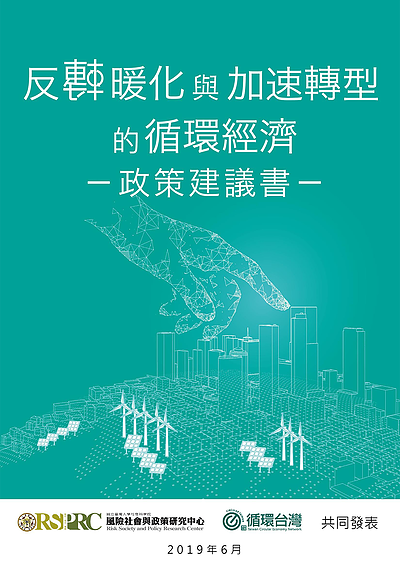In 2015, Taiwan passed the Greenhouse Gas Reduction Management Law, outlining the long-term goal that greenhouse gas emission in 2050 must be 50% lower than the greenhouse gas emission level of 2005. Between 2017-2018, legislations such as the “National Action Plan for Climate Change,” “Greenhouse Gas Reduction Plan,” and “Greenhouse Gas Emission Control in Six Major Sectors” were approved one after another. Yet despite these efforts, recent discussions regarding carbon reduction have mostly been focused on generating electricity through reduced coal burningthrough coal burning on a small scale and selection of power choices. If Taiwan’s carbon emission through energy consumption was analyzed in detail, 50% of the carbon dioxide emitted would come from the industrial sector. Thus, a more circular economy that can reduce carbon emission must be considered from the demand side.
In the fifth evaluation report published in 2014 by the United Nations Intergovernmental Panel on Climate Change (IPCC), circular economy strategies such as material efficiency, product-service efficiency and service needs, were emphasized to stress the importance of carbon reduction to companies. In 2019, the International Energy Agency published the “Material Efficiency in Clean Energy Transitions” report, which pointed out that by improving material efficiency, a 30% reduction in carbon emission can be achieved. The EU study also mentioned that the industrial sector can reduce approximately 56% of the carbon emission with a circular economy, which would help countries to reach the 2050 net zero emission target.
Based on current international trends, the EU released a report titled “A Clean Planet for All” in late November 2018 which stated that amongst all the strategies to reduce greenhouse gas, the circular economy has the most potential to meet the necessary criteria for a net zero emissions goal. The Draft Integrated National Energy and Climate Plan 2021- 2030 submitted by Holland to the EU views national promotion of the circular economy as a major component to fulfilling a nation’s climate change commitment. The national policies that are set in place will ultimately have a significant impact on defining the reduction responsibilities of each industry.
When analyzed in detail, Taiwan’s carbon dioxide emission mainly comes from the refining of key materials such as oil, petrochemical, steel, and cement. Combined, they make up a third of Taiwan’s carbon dioxide emission. However, these four industries have potential for a 20 – 75% dematerialization and material efficiency improvement rate.
If we use this opportunity to engage the circular economy and improve the efficiency rate of the four aforementioned industries, Taiwan’s carbon emissions could be reduced by 37.66 million tons, which could increase Taiwan’s ability to meet the 2050 greenhouse gas reduction emissions goal by 30%. This would demonstrate that the circular economy is a crucial element towards Taiwan’s goal of significant carbon reduction.
In reviewing Taiwan’s current Greenhouse Gas Reduction policy, every department has proposed increasing the development of low carbon recycling products, promoting material flow cost analysis, and decreasing the use of one-time use plastic. However, there are still four key areas that need to be addressed: comprehensive analysis of policy objectives, the lack of climate change considerations in the circular economy promotion plan, the need to strengthen policy tools, and more emphasis on waste recovery. Thus, this paper proposes the following 5 recommendations to promote circular economy:
- accelerate the integration of energy resources between industrial zones and hi-tech science parks
- implement policy tools
- integrate national greenhouse gas reduction plans in circular economy developments
- push industries to invest in R&D towards remanufacturing and reuse technologies
- design an integrated industry carbon reduction roadmap.
